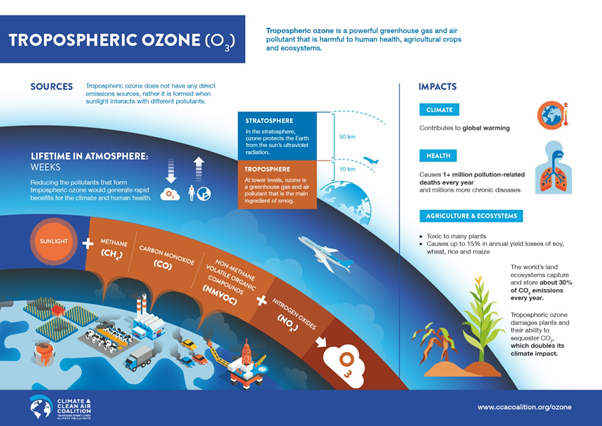

4th June 2022 (6 Topics)
Context
An analysis by Centre for Science and Environment found that unprecedented level of ozone pollution has marked summer 2022 in Delhi and several other Indian metropolitan cities.
About
What is Ozone?
- Ozone is a colorless gas made up of three oxygen atoms.
- Ozone is not emitted directly into the air but is formed through chemical reactions between natural and man-made emissions of nitrogen oxides (NOx) and volatile organic compounds (VOCs) in the presence of sunlight.
- These gaseous compounds mix like a thin soup in the ambient, or outdoor, air, and when they interact with sunlight, ozone is formed.
- Ozone can be split into two major types:
- Stratospheric Ozone:Stratospheric ozone or the "ozone layer" forms high in the atmosphere, 6-30 miles above the earth's surface, when intense sunlight causes oxygen molecules (O2) to break up and re-form as ozone molecules (O3).
- These ozone molecules form the ozone layer and are commonly referred to as "good ozone."
- At concentrations as high as 12,000 ppb (the EPA considers anything over 70 ppb to be unhealthy for human health and welfare) this ozone protects and shields people, trees, crops, property, and microorganisms from the harmful effects of the sun's ultraviolet light.
- Ground-Level Ozone:Tropospheric, or ground-level ozone, is created by chemical reactions between:
- Stratospheric Ozone:Stratospheric ozone or the "ozone layer" forms high in the atmosphere, 6-30 miles above the earth's surface, when intense sunlight causes oxygen molecules (O2) to break up and re-form as ozone molecules (O3).
-
-
- oxides of nitrogen (NOx)
- volatile organic compounds (VOC)
-
-
-
-
- Ground-level ozone forms just above the earth’s surface (up to about 2 miles above ground) and impacts human, animal, and plant respiration.
- It usually increases when pollutants emitted by cars, power plants, industrial boilers, refineries, chemical plants, and other sources chemically react in the presence of sunlight, impacting human health.
-
-
Why ‘Ground-level ozone’ is ‘bad ozone’?
- Although ground-level ozone is less concentrated than stratospheric ozone, its impacts on human health and welfare make ground-level ozone "bad ozone."
- Ground-level ozone is an irritantand can negatively affect human health and welfare.
- Weather plays a substantial role in formation of ground level ozone.
- Ground-level ozone concentrations typically are highest on warm/hot days with low humidity when wind is light or stagnant.

Highlights from the analysis:
- Heatwaves advanced the geographical spread of ground-level ozone
- Geographical spread of ground-level ozone pollution in Delhi-NCR during March-April highest in past four years
- New Delhi and south Delhi neighbourhoods are worst affected by ground-level ozone pollution
- East and central Delhi are facing worsening trend
- Ground-level ozone hotspots are located in the areas with low levels of NO2 and PM2.5
- Hourly ozone peak levels are up by 23 per cent compared to lockdown times
- Night-time ground-level ozone continues to persist
- Ground-level ozone has become a year-long problem
- During the summer of 2022 all key pollutants have increased in Delhi-NCR
|
About Centre for Science and Environment (CSE):
|



